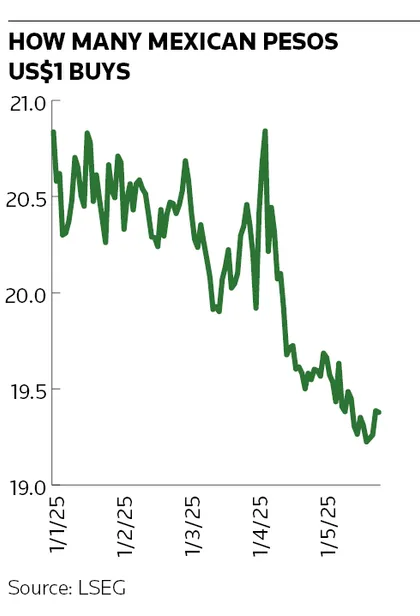TACO trade proves a gift for Mexico
US president Donald Trump's erratic trade policy has triggered a sharp rally in the Mexican peso, transforming the currency from a market punching bag into a favourite hedge fund bet in a matter of months.
The currency hit a peak of Ps19.18 against the US dollar on May 26, its highest level since early October before Trump's election victory. That caps a remarkable turnaround for the currency after it hit a three-year low of Ps21.17 in February when investors dumped the peso after Trump first announced punitive tariffs against Mexico and Canada.
The peso's rally makes it one of the most high-profile beneficiaries of the so-called TACO trade on Wall Street. "Trump always chickens out" refers to the now familiar pattern of the president announcing sky-high tariffs only later to walk them back.
The economic uncertainty stemming from this yo-yoing trade policy has weighed on the dollar in recent months, prompting investors to cast around for alternatives including high-yielding emerging market currencies like the peso.
Kristjan Kasikov, global head of FX quantitative investor solutions at Citigroup, said hedge funds have been bulk-buying the peso since the second half of April, meaning many would have profited handsomely from a 7% appreciation against the dollar since then.
“The recent Mexican peso performance we have seen is more a story of US dollar weakness rather than Mexican strength,” said Erick Rafael, FX and EM macro strategist at Barclays. “There’s a lot of uncertainty around US policy, which is fuelling concern around the end of US exceptionalism. We’ve certainly seen investors reducing their concentration in US assets and looking for alternatives."
Trump's shifting trade policies have changed the narrative in currency markets this year. A historic rally in the dollar that followed his election in November has come to a screeching halt, while a range of other currencies from the euro to the peso – which until recently had looked vulnerable – has steadily strengthened.
ICE’s US Dollar Index, which measures the greenback against a basket of currencies, has slid 8% since the start of the year, and 4% since April 2 when Trump announced his sweeping series of tariffs that he has since watered down. That decline has come amid mounting concerns over the damage that these see-sawing trade policies will have on the US economy and the dollar's status as a safe-haven currency. Many FX traders have subsequently decided to invest in alternative currencies amid widespread expectations that the dollar will continue to come under pressure in the months ahead.
The peso reached its recent high in the wake of Trump threatening on May 23 to impose a 50% tariff on all European Union goods, only to drop those plans two days later. The peso held steady after a US federal trade court injected still more uncertainty into the fate of Trump's tariff policies by ruling on Wednesday that most are illegal – a decision the White House is appealing.
Carry on
While Mexico faces an average tariff of 23% from the US, according to analysis by BBVA, it is one of the few countries not to face additional “reciprocal” tariffs from Washington due to the countries' trade agreement. That has boosted the attractiveness of the peso as an alternative to the dollar among investors, traders say, and many have been buying the currency due to the yield they can achieve through FX carry trades.
That trade – in which investors borrow cheaply in the low-yielding dollar to buy higher-yielding pesos to profit from the interest rate differentials between the two markets – has provided an average return of 8% this year, said Kasikov, making it one of the “most attractive” carry trades within Latin American currencies at the moment.
“Fast-money investors will definitely be taking advantage of carry trades after this peso appreciation,” said Rafael. “We have a positive view on Mexican peso carry trades and believe they will continue to perform well into the summer, especially within an environment where the US dollar remains weak.”
Not everyone believes the peso's strength will last, however. Bank of America FX strategists said the currency has “returned to overvalued territory” given the probability the Mexican economy enters a recession later this year amid declining growth expectations and rising inflation. Mexico only narrowly avoided a recession at the beginning of this year after contracting 2.5% in the fourth quarter.
"The [peso] has benefited from a positive narrative on trade," said Joseph Incalcaterra, head of LatAm FX strategy at HSBC. "This could change, however, as we think the market may be underestimating some risks surrounding [Mexico's trade agreement with the US] while further rate cuts from the Mexican central bank could also prevent further [peso] gains."






